Anti-aircraft gun missile system "Tunguska"
Despite the successful use of "Shilka" in the Middle East wars, during the fighting, its shortcomings were also revealed - a small target reach (at a distance of no more than 2 thousand meters), poor projectiles power, and missiles of targets not shot due to the impossibility of timely detection.
Worked the expediency of increasing the caliber of anti-aircraft automatic guns. In the course of experimental studies, it turned out that switching from an 23-millimeter projectile to an 30-millimeter-projectile with a two- to threefold increase in the weight of an explosive material makes it possible to reduce the necessary number of hits for the destruction of an aircraft 2-3. Comparative calculations of the combat effectiveness of the ZSU-23-4 and ZSU-30-4 in firing at the MiG-17 fighter, which flies at a speed of 300 meters per second, showed that with the same weight of the spent ammunition set, the probability of destruction increases approximately 1,5 times, reach in height, it increases from 2 to 4 kilometers. When increasing the caliber of guns, the effectiveness of fire on ground targets increases, the possibilities of using projectiles of cumulative action in an anti-aircraft self-propelled installation to destroy lightly armored targets like BMP, etc., are expanding.
The transition of automatic anti-aircraft guns from the 23 caliber of millimeter to the 30 caliber of millimeters had practically no effect on the rate of firing, however, with its further increase, it was impossible to technically provide high rate of fire.
The Shilka anti-aircraft self-propelled unit had very limited search capabilities, which were provided by its target tracking radar in the sector from 15 to 40 degrees in azimuth while simultaneously changing the elevation angle within 7 degrees from the set direction of the antenna axis.
The high effectiveness of the ZSU-23-4 fire was achieved only when receiving preliminary target indications from the PU-12 (M) battery pack, which used data received from the command post of the air defense chief of the division, which had a P-15 or P-19 radar station . Only after this, the radar station ZSU-23-4 made a successful search for targets. In the absence of radar target designations, an anti-aircraft self-propelled unit could carry out an independent circular search, however, the detection efficiency of air targets turned out to be less than 20 percent.
The Research Institute of the Ministry of Defense determined that to ensure autonomous operation of a promising anti-aircraft self-propelled installation and high firing efficiency, it should include its own circular radar viewing station with a range of up to 16-18 kilometers (with standard deviation of XRUMX meters). The review of this station in the vertical plane must be at least 30 degrees.
However, the development of this station, which was a new additional element of an anti-aircraft self-propelled unit, was agreed upon only after careful consideration of the materials of the spec. research conducted in 3 Research Institute of the Ministry of Defense. To extend the zone of shelling to the line of use by the enemy onboard weaponsAs well as to increase the combat power of the Tungusk self-propelled self-propelled gun, at the initiative of 3, the Research Institute of the Defense Ministry and the Air Defense Directorate MOP was deemed expedient to supplement the installation with rocket armament with an optical sighting system and radio remote control of anti-aircraft guided missiles, providing target destruction at distances up to 8 thousand m to 3,5 th. m.
However, the expediency of creating an anti-aircraft cannon-missile system in the office of AA Grechko, Minister of Defense of the USSR, caused great doubts. The reason for the doubts and even to stop financing the further design of the Tungusk self-propelled anti-aircraft installation (from 1975 to 1977) was that the Osa-AK air defense missile system, which was put into service in the 1975 year, had a close range of damage to the aircraft in range (10 thousand m) and larger than the Tunguska, the size of the affected area in height (from 25 to 5000 m). In addition, the performance characteristics of the destruction of the aircraft were about the same.
However, they did not take into account the specifics of the armament of the regimental anti-aircraft defense unit, for which the installation was intended, and the fact that the Osa-AK anti-aircraft missile system was significantly inferior to the Tunguska when fighting with helicopters, since it had a longer working time - 30 seconds against 10 seconds at the anti-aircraft installation "Tunguska". The short reaction time of the Tunguska ensured a successful fight against “jumping” (short-term) or suddenly flying out of shelters by helicopters and other targets flying at low altitudes. SAM "Osa-AK" could not provide this.
The Americans in the Vietnam War for the first time used helicopters that were armed with an anti-tank missile (anti-tank guided missile). It became known that from 91 approach of helicopters armed 89 ATGM proved to be successful. Helicopters attacked the firing positions of artillery, objects of armored vehicles and other ground targets.
Based on this combat experience, helicopter special forces were created in each American division, the main purpose of which was the fight against armored vehicles. A group of fire support helicopters and a reconnaissance helicopter occupied a position hidden in the folds of the terrain at a distance of 3-5 thousand meters from the line of combat contact. On approach tanks the helicopters “jumped” to it 15-25 meters up, hit the enemy’s equipment with the help of ATGMs, and then quickly disappeared. Tanks in such conditions were defenseless, and American helicopters - with impunity.
In 1973, by the decision of the government, a special integrated research project “Zamruda” was set up to search for ways to protect the ground forces, and especially tanks and other armored vehicles from enemy helicopter strikes. The head executor of this complex and large research work was identified by the 3 Research Institute of the Ministry of Defense (the supervisor was SI Petukhov). On the territory of the Donguz landfill (head of the landfill, Dmitriev OK), in the course of this work, conducted an experimental exercise led by V. Gatsolaev. with combat firing different types of weapons of SV on target helicopters.
As a result of this work, it was determined that the means of reconnaissance and destruction that modern tanks have, as well as the weapons used to destroy ground targets in tank, motorized rifle and artillery formations, are not capable of hitting the helicopters in the air. The Osa anti-aircraft missile systems are capable of providing reliable cover for tanks from aircraft strikes, but cannot provide protection against helicopters. The positions of these complexes will be in 5-7 kilometers from the positions of helicopters, which during the attack will "jump" and hang in the air for 20-30 seconds. According to the total reaction time of the air defense missile system and the flight of the guided missile to the line of location of the helicopters, the Osa and Osa-AK complexes cannot hit the helicopters. The Strela-1, Strela-2 and Shilka installations are also unable, by combat capabilities, to fight helicopter gunships using similar tactics.
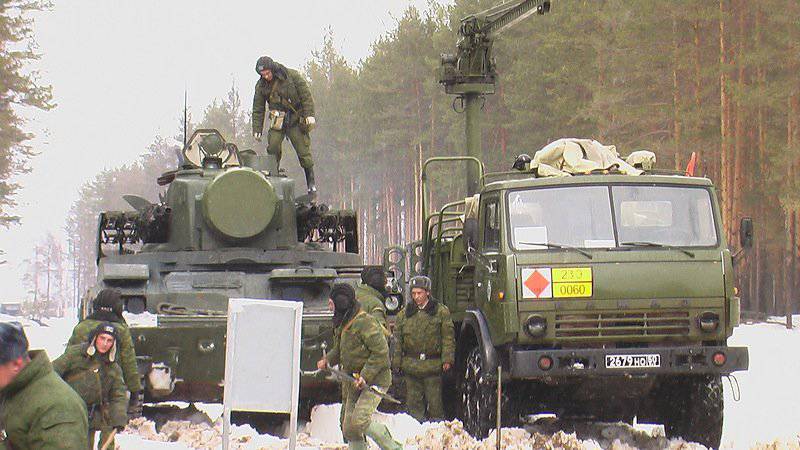
The only anti-aircraft weapon, effectively fighting hovering helicopters, could be the Tunguska self-propelled anti-aircraft installation, which had the ability to accompany the tanks, being part of their battle formations. ZSU had a short working time (10 seconds) as well as a sufficiently distant border of its affected area (from 4 to 8 km).
The results of the research work "Dam" and other add. The studies that were carried out at the 3 Research Institute of the Ministry of Defense on this issue, have allowed to achieve the resumption of funding for the development of the Tunguska ZSU.
The development of the "Tungusk" complex was generally carried out in the MOP KBP under the direction of the chief designer A.G. Shipunov. The main designers of the rocket and cannons, respectively, were Kuznetsov V.M. and Gryazev V.P.
Other organizations were also involved in the development of fixed assets of the complex: Ulyanovsk Mechanical Plant MCI (developed the radio receiving complex, chief designer Ivanov Yu.E.); Minsk tractor factory MSHM (developed the GM-352 tracked chassis and power supply system); VNII "Signal" MOP (guidance systems, stabilization of the optical sight and the line of the shot, navigation equipment); LOMO MOP (optical sighting equipment), etc.
Joint (state) tests of the Tungusk complex were held in September 1980 of the year - December 1981 of the year at the Donguz testing ground (head of the Kuleshov range, I.I.) under the guidance of a commission headed by Yu. P. Belyakov. By a decree of the Central Committee of the CPSU and the USSR Council of Ministers of the 08.09.1982 complex adopted.
The structure of the 2X6 combat vehicle of the Tunguska anti-aircraft gun (2K22) included the following fixed assets placed on a tracked self-propelled vehicle with high permeability:
- cannon armament, including two 2А38 X-guns of caliber 30 mm with a cooling system, ammunition ammunition;
- rocket armament, including 8 launchers with guides, ammunition 9М311 anti-aircraft missiles in TLC, coordinate positioning equipment, encoder;
- power hydraulic actuators targeting launchers Zour and guns;
- a radar system consisting of a target detection radar, a target tracking station, and a ground-based radio interrogator;
- digital calculating device 1А26;
- optical sighting equipment with a stabilization and guidance system;
- A system for measuring the course and swing;
- navigation equipment;
- equipment built-in control;
- communication system;
- life supporting system;
- system of automatic blocking and automation;
- anti-nuclear, anti-biological and chemical protection system.
The double-barreled 30-mm anti-aircraft machine gun 2А38 provided fire with cartridges supplied from the common for both barrels of cartridge tape with a single feed mechanism. The machine gun had a percussion firing mechanism that served both barrels in turn. Shooting control - remote by means of electrostart. In liquid cooling of the shafts, water or antifreeze was used (at low temperatures). The elevation angles of the machine are from -9 to + 85 degrees. The cartridge belt was composed of links and cartridges with fragmentation tracer shells and high explosive fragmentation shells (in the ratio 1: 4). Ammunition - 1936 shells. The overall rate of fire is 4060-4810 shots per minute. The machines ensured reliable operation in all operating conditions, including operation at temperatures from -50 to + 50 ° С, during icing, rain, dusting, shooting without lubrication and cleaning during 6 days with shooting 200 shells on the machine during the day, with fat-free (dry) parts of automation. Vitality without changing trunks - at least 8 thousand shots (firing mode at the same time - 100 shots on each machine with subsequent cooling). The initial velocity of the shells was 960-980 meters per second.
The 42-kilogram 9М311 missile (the mass of the rocket and transport and launch container - 57 kilogram) was built according to a bicalyber scheme and had a detachable engine. The single-mode rocket propulsion system consisted of a lightweight starter engine in a 152-mm plastic case. The engine reported the rocket speed in 900 m / s and after 2,6 seconds after launch, at the end of the work, it was separated. In order to exclude the effect of smoke from the engine on the process of optical sighting of missiles at the launch site, an arcuate programmed (over radio commands) missile output trajectory was used.
After the launch of the guided missile to the line of sight of the target, the marching stage of the missile defense system (diameter - 76 mm, weight - 18,5 kg) continued to fly by inertia. The average speed of the rocket - 600 m / s, while the average available overload was 18 units. This ensured defeat on catch-up and oncoming courses of targets moving at a speed of 500 m / s and maneuvering with overloads up to 5-7 units. The absence of the main engine eliminated the smoke line of the optical sighting, which ensured accurate and reliable guidance of the guided missile, reduced its size and weight, simplified the layout of combat equipment and onboard equipment. The use of the two-stage missile defense scheme with the 2: 1 diameters of the starting and marching stages made it possible to reduce the weight of the rocket by almost two times compared to a single-stage guided missile with the same LTH, since the engine separation significantly reduced the aerodynamic drag on the main part of the rocket trajectory.
The rocket’s combat equipment included a warhead, a proximity target sensor, and a contact fuse. The 9-kilogram warhead, which occupied almost the entire length of the marching stage, was made in the form of a compartment with pivotal striking elements, which, to increase efficiency, were surrounded by a fragmentation shirt. The warhead on the design elements of the target provided a cutting action and incendiary action on the elements of the fuel system of the target. In the case of small blunders (up to 1,5 meters), a high-explosive action was also provided. The undermining of the warhead was carried out by a signal of a proximity sensor at a distance of 5 meters from the target, and with a direct hit on the target (probability about 60 percent) was carried out by a contact fuse.
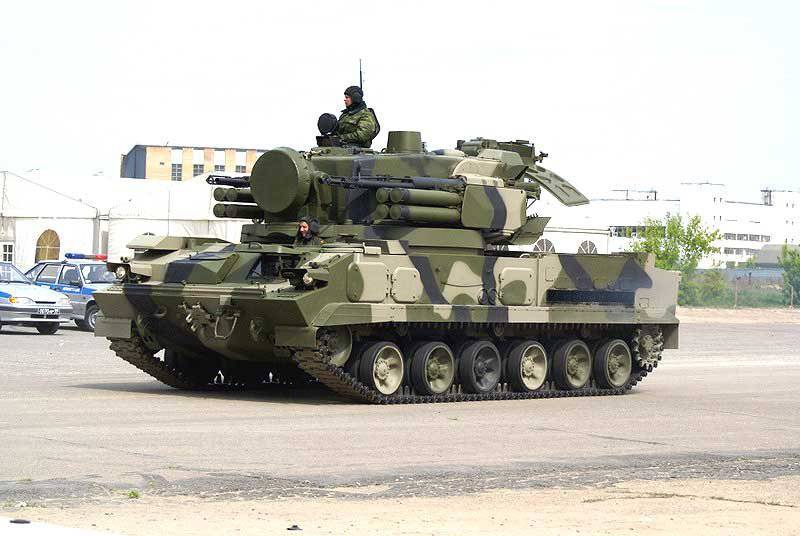
Non-contact sensor weight 800 gr. consisted of four semiconductor lasers, which form an eight-radiation pattern perpendicular to the rocket longitudinal axis. The reception of the laser signal reflected from the target was carried out by photodetectors. The range of reliable operation - 5 meters, reliable failure - 15 meters. The cocking of the proximity sensor took place on radio commands for 1000 m prior to the meeting of the guided missile with a target, when shooting at ground targets before launching the sensor was turned off. The missile control system had no height limits.
The onboard equipment of the guided missile included: an antenna-waveguide system, a gyroscopic coordinator, an electronic unit, a steering gear unit, a power unit, a tracer.
In Zour used passive aerodynamic damping of the airframe of the rocket in flight, provided the correction control loop command transmission from the computer system BM on the rocket. This made it possible to obtain sufficient pointing accuracy, reduce the size and weight of the onboard equipment and the anti-aircraft guided missile as a whole.
Rocket length - 2562 millimeter, diameter - 152 millimeter.
The station for detecting targets of the BM "Tungusk" complex is a coherent-impulse radar station with a circular review of the UHF range. The high frequency stability of the transmitter, which was designed as a master oscillator with an amplifying chain, the use of a filtering scheme for selecting targets provided a high coefficient of suppression of the reflected signals from local objects (30 ... 40 dB). This made it possible to detect the target against the background of intense reflections from the underlying surfaces and in passive interference. By selecting the values of the pulse repetition frequency and the carrier frequency, an unambiguous definition of the radial velocity and range was achieved, which made it possible to implement target tracking in azimuth and range, automatic target designation of the target tracking station, and output to the digital computing system of the current range when placing intense interference by the enemy in the station range escorts. To ensure operation in motion, the antenna was stabilized by an electromechanical method using signals from the sensors of the course measurement system and the self-propelled roll.
With transmitter transmitter power from 7 to 10 kW, receiver sensitivity around 2x10-14 W, antenna beam width 15 ° in elevation and 5 ° in azimuth, the station with probability 90% ensured detection of a fighter that flies at altitudes from 25 to 3500% at 16 to 19 to 500%. , at a distance 5-6 kilometers. Station resolution: in range 15 m, in azimuth 20-1 °, in elevation within 5 °. RMS of determining the coordinates of the target: in the range XNUMX m, in the azimuth XNUMX °, in the elevation angle XNUMX °.
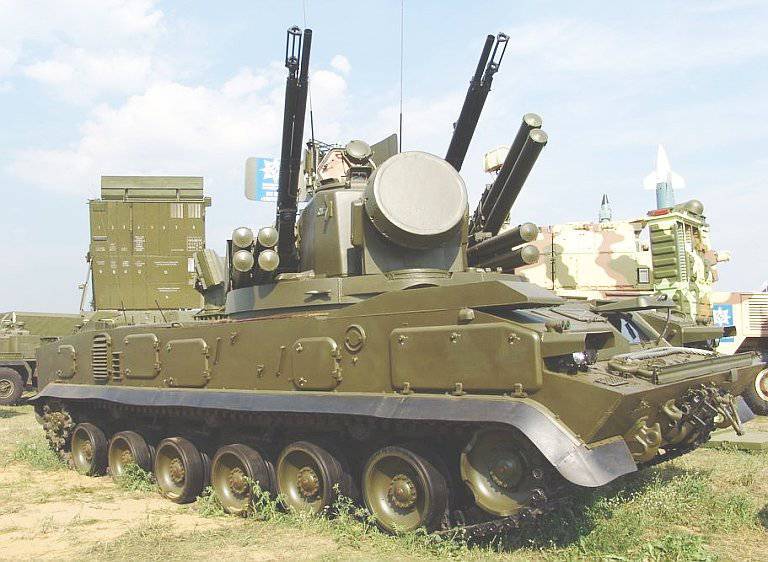
The target tracking station is a centimeter coherent-pulse radar station with a two-channel tracking system for angular coordinates and filtering schemes for the selection of moving targets in the channels of the angular tracking and auto-range. The reflection coefficient from local objects and the suppression of passive interference - 20-25 dB. The station made the transition to automatic tracking in sector search and target designation modes. Search sector: in azimuth 120 °, in elevation 0-15 °.
With the receiver sensitivity 3X10-13 watts, pulse power of the transmitter 150 kilowatts, width of the 2 antenna pattern of the degree (in elevation and azimuth), the station with the probability 90% ensured the transition to automatic tracking by three coordinates of the fighter flying at altitudes from XNXXXXXXXXXXXXXXXXXXXXXXXXX9XXX9Xx from ranges 25-1000 thousand m (when receiving target designation from the detection station) and with 10-13 thousand m (with autonomous sector search). The resolution of the station: the range 7,5 m, the angular coordinates 8 °. RMS target tracking: 75 m in range, 2 d. by angular coordinates.
Both stations were very likely to detect and escort hovering and low-flying helicopters. The detection range of a helicopter flying at an altitude of 15 meters with a speed of 50 meters per second, with a probability of 50%, was 16-17 kilometers, and the transition distance to automatic tracking was 11-16 kilometers. The hanging helicopter was detected by the detection station due to the Doppler frequency shift from the rotating propeller; the helicopter was taken to the auto tracking of the target tracking station in three coordinates.
The stations were equipped with circuit protection devices against active interference, and were also able to accompany targets with interference through a combination of the use of optical and radar BM facilities. Due to these combinations, separation of working frequencies, simultaneous or regulated by the time of operation at close frequencies of several (located at a distance more than 200 meters), the BM as part of the battery provided reliable protection against Standard-type or Shrayk missiles.
The 2C6 combat vehicle basically operated autonomously, however, work in the control system of the ground forces air defense systems was not excluded.
During the battery life provided:
- target search (all-around search - using a detection station, sector search - using an optical sight or tracking station);
- identification of the state accessories of the detected helicopters and airplanes using the built-in interrogator;
- tracking of targets by angular coordinates (inertial - according to data from a digital computing system, semi-automatic - using an optical sight, automatic - using a tracking station);
- tracking of targets in range (manual or automatic - using a tracking station, automatic - using a detection station, inertial - using a digital computing system, at a set speed determined by the commander visually according to the type of target chosen for the shelling).
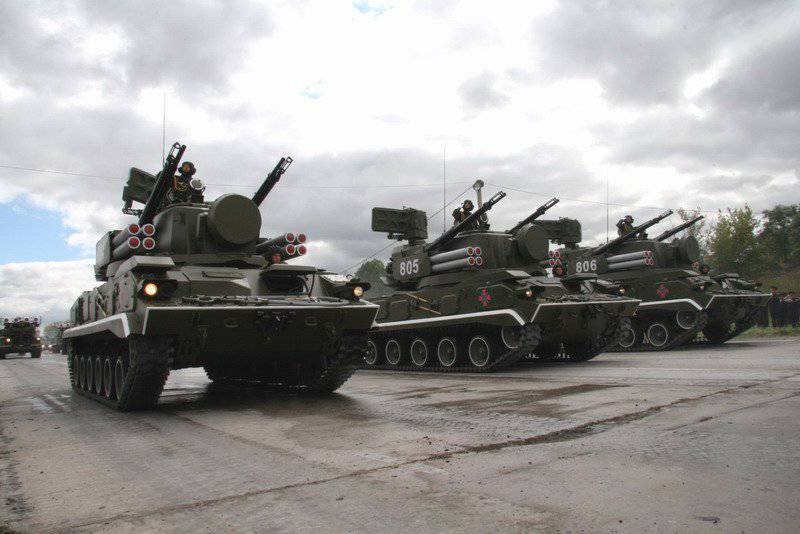
The combination of different methods of tracking the target in range and angular coordinates provided the following modes of operation of the BM:
1 - in three coordinates, obtained from the radar system;
2 - in range, obtained from the radar system, and angular coordinates obtained from an optical sight;
3 - inertial support in three coordinates, obtained from the computer system;
4 - on the angular coordinates obtained from the optical sight and target speed set by the commander.
When firing at moving ground targets, the manual or semi-automatic aiming of weapons at the distance grid of the sight at a pre-empt point was used.
After searching, detecting and recognizing a target, the target tracking station switched to its automatic tracking in all coordinates.
The digital computer system, when firing anti-aircraft guns, solved the task of meeting the projectile and the target, and also determined the affected area using information from the output shafts of the target tracking station antenna, from a range finder and from the unit for selecting the error signal by the angular coordinates kachek BM. When the enemy set up an intense jamming, the target tracking station switched to manual tracking in range, and if manual tracking was not possible, to inertial tracking of the target or tracking from the detection station. In the case of intensive interference, the tracking was carried out with an optical sight, and in the case of poor visibility - from a digital computer system (inertia).
With rocket fire, target tracking using angular coordinates with an optical sight was used. After launch, the anti-aircraft guided missile fell into the field of the optical direction finder of the ZOR coordinate detection equipment. The equipment on the light signal of the tracer produced the angular coordinates of the guided missile relative to the line of sight of the target, entering the computer system. The system produced rocket control commands, which arrived at the encoder, where they were encoded into pulses and transmitted to the rocket via the tracking station transmitter. Rocket movement on almost the entire trajectory occurred with a deviation on 1,5 d. from the line of sight of the target to reduce the likelihood of a thermal (optical) interfering trap being fired into the field of view of the direction finder. Entering the SAM on the line of sight began approximately 2-3 seconds before the meeting with the goal, ended near it. When an anti-aircraft guided missile approached a target at a distance of 1 km, the radio command transmitted a non-contact sensor cocking command. After a time that corresponded to the 1 km missile from the target expired, the BM automatically became ready to launch the next guided missile on the target.
In the absence of data on the distance to the target from the detection or tracking station in the computer system, an additional guidance mode of an anti-aircraft guided missile was used. In this mode, the missile defense system on the line of sight of the target was displayed immediately, the proximity sensor was cocked after 3,2 seconds passed after the launch of the rocket, and the BM was alerted to launch the next rocket after the flight time of the guided missile had reached its maximum range.
The 4 BM Tunguska complex was organized into an anti-aircraft missile-artillery platoon of a rocket-artillery battery, which consisted of a Strela-10SV anti-aircraft missile system platoon and a Tungusk platoon. The battery, in turn, was part of the anti-aircraft division of the tank (motorized rifle) regiment. The command post PU-12М, connected with the command post of the anti-aircraft battalion commander - the regiment's air defense commander, served as the battery commander's station. The KP commander of the anti-aircraft division served as the command post of the air defense units of the Ovod-M-SV regiment (PPRU-1, mobile reconnaissance and control center) or Assembling (PPRU-1М) - its modernized version. In the future, the BM of the Tunguska complex were mated with a unified battery pack KP Ranzhir (9С737). When the PU-12М and the Tunguska complex were paired, the control and targeting commands from the PU to the combat vehicles of the complex were transmitted by voice using standard radio stations. When pairing with the control unit 9C737, the commands were transmitted using codograms generated by the data transmission equipment available on them. When controlling the "Tunguska" complexes from the battery KP, the analysis of the air situation, as well as the selection of targets for firing by each complex, should have been carried out at this point. In this case, target vehicles and orders were to be transferred to combat vehicles, and information on the status and results of the operation of the complex was transferred from the complexes to the battery gearbox. In the future, it was supposed to provide a direct connection of the anti-aircraft cannon-missile complex with the command post of the regiment's air defense chief with the help of a telecode data transmission line.
The work of the combat vehicles of the Tungusk complex was ensured by the use of the following machines: 2F77М transport-charging vehicles (based on KAMAZ-43101, drove 8 missiles and 2 ammunition ammunition); repair and maintenance of 2F55-1 (Ural-43203, having a trailer) and 1Р10-1М (Ural-43203, maintenance of electronic equipment); maintenance 2В110-1 (Ural-43203, artillery unit maintenance); 93921 test and test automated mobile stations (GAZ-66); maintenance workshops MTO-ATG-M1 (ZIL-131).
The "Tunguska" complex was modernized by the middle of 1990, and received the name "Tunguska-M" (2K22М). The main refinements of the complex concerned the introduction of the composition of the new receiver and radio stations for communicating with the Rangir battery switchgear (PU-12М) and PRRU-1М switchgear (PRRU-1), replacing the gas turbine engine of the electric power supply unit of the complex with an increased service life (600 hours instead of 300).
In August-October 1990, the 2K22М complex was tested at the Emben training ground (the head of the Unuchko VR landfill) under the guidance of a commission headed by Belotserkovsky A.Ya. In the same year the complex was put into service.
Serial production of "Tunguska" and "Tunguska-M", as well as its radar tools, was organized at the Ulyanovsk Mechanical Plant of the Ministry of Radio Industry, gun armament was organized at the TMZ (Tula Mechanical Plant), missile weapons - at the KMZ (Kirov Machine Building Plant) "Mayak" of the Ministry of Defense Industry, optical sighting equipment - at LOMO of the Ministry of Defense. Tracked self-propelled vehicles and their support systems were supplied by MTZ MSRM.
Lenin Prize winners were Golovin A.G., Komonov P.S., Kuznetsov V.M., Rusyanov A.D., Shipunov A.G., State Prize - Bryzgalov N.P., Vnukov V.G., Zykov I.P., Korobkin V.A. and etc.
In the modification of the "Tunguska-M1", the processes of guiding anti-aircraft guided missiles and data exchange with the battery KP were automated. The non-contact laser target sensor in the 9М311-М rocket was replaced with a radar sensor, which increased the probability of an ALCM-type missile being hit. Instead of a tracer, a flash lamp was installed - efficiency increased by 1,3-1,5 times, and the range of the guided missile reached 10 thousand. M.
On the basis of the collapse of the Soviet Union, work is underway to replace the GM-352 chassis, produced in Belarus, with the GM-5975 chassis, developed by the Metrovagonmash production plant in Mytishchi.
Further development of the main tech. decisions on the Tunguska complexes were carried out in the Pantsir-S anti-aircraft cannon-missile system, which has a more powerful anti-aircraft guided missile 57-6. The range of launches increased to 18 thousand meters, the height of the targets hit - to 10 thousand meters. A more powerful engine was used in the guided missile of this complex, the weight of the warhead was increased to 20 kilograms, its caliber increased to 90 millimeters. The diameter of the instrument compartment has not changed and was 76 millimeters. The length of the guided missile increased to 3,2 meters, and the mass - to 71 kilogram.
The anti-aircraft missile system provides simultaneous bombardment of 2 targets in the sector 90x90 degrees. High noise immunity is achieved through the joint use of a set of tools in the infrared and radar channels of a complex that operate in a wide range of wavelengths (infrared, millimeter, centimeter, decimeter). The anti-aircraft missile system provides for the use of a wheeled chassis (for the Air Defense Forces of the Country), a stationary module or a tracked self-propelled one, and also a ship variant.
Another direction of the creation of new air defense systems has become implemented by the design office of precision engineering to them. Nudelman development towed ZRPK "Pine".
In accordance with the article of the chief - chief designer of the design bureau Smirnov B. and deputy. V. Kokurin, Chief Designer, in Military Parade Magazine No. XXUMX, 3 of the year; the complex located on the trailer chassis includes: a double-barreled anti-aircraft gun 1998А2М (rate of fire - 38 shots per minute) with a shop for 2400 shots; operator's cabin; optical-electronic module developed by the production association "Ural Optical-Mechanical Plant" (with laser, infrared and television tools); guidance mechanisms; digital computer system based on the 300B1-563-36 computer; Autonomous power supply system having a battery and gas turbine power unit АП10Д.
The artillery base version of the system (the weight of the complex is 6300 kg; height is 2,7 m; length is 4,99 m) can be supplemented with 4 anti-aircraft Igla or 4 guided missiles with prospective guided missiles.
According to the Janes Defense Weekly publisher from 11.11.1999, the 25-kilogram Sinna-P rocket 9М337 is equipped with an 12-channel laser fuse and 5 kilogram warhead. The range of the missile 1,3-8 km, height - up to 3,5 km. Flight time to the maximum range - 11 seconds. The maximum flight speed in 1200 m / s is one third higher than the corresponding Tunguska indicator.
The functional and layout of the rocket is similar to the rocket of the Tunguska anti-aircraft missile system. The diameter of the engine - 130 millimeters, the march stage - 70 millimeters. The radio command control system has been replaced by a more noise-resistant laser beam guidance equipment, developed taking into account the experience of using tank-guided missile systems developed by Tula KBP.
The mass of the transport and launch container with a missile - 36 kg.
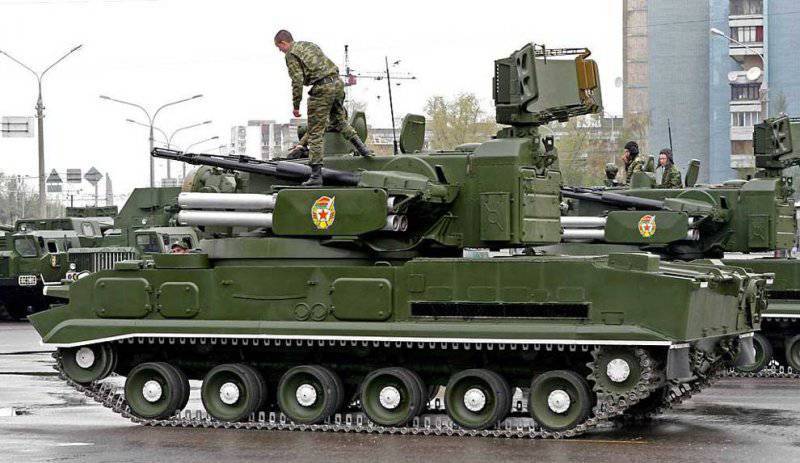
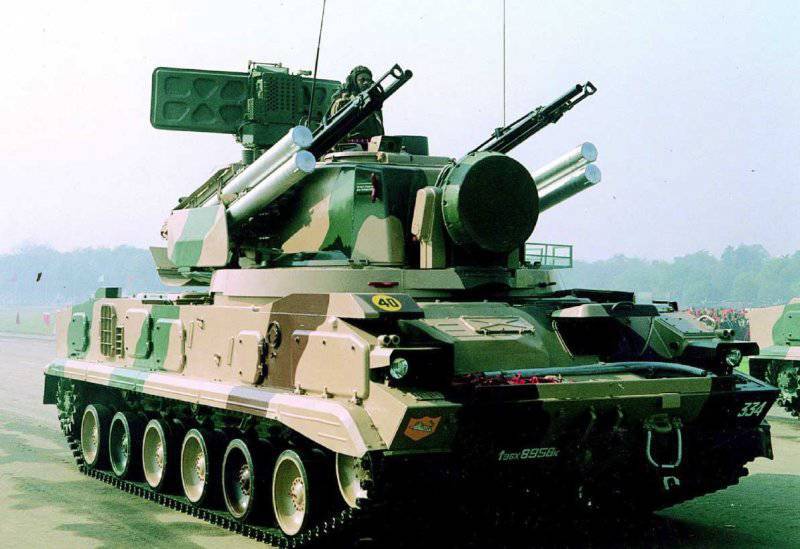

Information